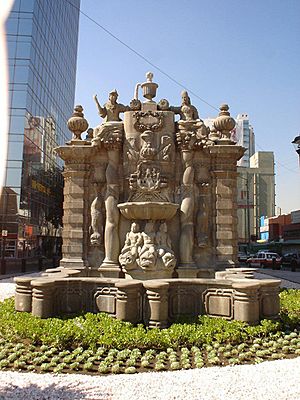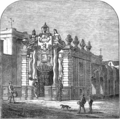Chapultepec aqueduct facts for kids
The Chapultepec Aqueduct was a super important water system built to bring fresh, clean water to Tenochtitlan, which is now known as Mexico City. Tenochtitlan was the capital city of the powerful Aztec Empire. This empire was a team-up of three Nahua states: Tenochtitlan, Tetzcoco, and Tlacopan, formed way back in 1428. The aqueduct carried fresh water all the way from the Chapultepec springs.
The Aztecs actually built two aqueducts along the same path during the 1400s. The first one was destroyed by a big flood. The second one was later destroyed by the Spanish during their conquest. After the Spanish arrived and took control, they built their own colonial aqueduct. You can still see parts of its ruins today near the Metro Sevilla subway station.
Contents
What Was the Chapultepec Aqueduct?
Imagine a city built on a lake, like Tenochtitlan. The water right under the city was salty, or "brackish," which means it wasn't good for drinking or cooking. People dug shallow wells for water to wash with, but they needed a source of fresh water for everything else.
So, in 1418, the Aztecs started building an aqueduct to bring fresh water from the Chapultepec springs. This water was perfect for drinking and cooking!
The First Aztec Aqueduct
Building the first aqueduct was a clever feat of engineering. The builders used mud and plant materials to create a base. This base rested on small, man-made islands that were spaced about 3 to 4 meters apart. On these islands, they built mud mounds and pushed wooden stakes through them for support.
At the top of each mound, there was a hollowed-out channel lined with packed clay. To connect the channels between the islands, they used hollowed-out logs. A wooden walkway ran alongside the aqueduct, making it easy to reach and also serving as a path from the city to nearby areas. Once the water reached Tenochtitlan, it flowed into small storage pools and then through a network of canals to different homes.
However, this first aqueduct wasn't strong enough to last forever. The packed clay wore away over time. In 1449, very heavy rains caused a huge flood that completely destroyed the aqueduct. This left Tenochtitlan without fresh water for weeks!
Building a Stronger Aqueduct
After the first aqueduct was destroyed, the king of Texcoco, Nezahualcoyotl, ordered a new one to be built. This time, they used much stronger materials and followed the same route.
The second aqueduct had two channels, or troughs, made of stone masonry and lined with mortar. Having two channels was a brilliant idea! If one channel needed repairs or cleaning, they could switch the water flow to the other one. This meant the city always had a continuous supply of fresh water. Like the first aqueduct, this one also rested on a series of artificial islands. The channels were secured to these islands using wooden posts set into a base of sand, lime, and rock. The aqueduct was built with wood, carved stone, and packed soil. Some parts even used hollowed logs, allowing canoes to pass underneath.
The Spanish Colonial Aqueduct
When Hernán Cortés arrived in the Aztec Empire, he quickly understood how important the Chapultepec aqueduct was for the city's economy and power. He used the city's reliance on the aqueduct to his advantage, blocking the fresh water supply and eventually destroying it.
Soon after the Spanish conquest, Cortés wanted to claim the Chapultepec forest for himself. But King Charles V of Spain said no. He declared that the springs were essential for providing drinking water to the people and therefore belonged to the city of Tenochtitlan.
Construction of a brand new aqueduct began under a Spanish leader called a Viceroy, Fernando de Alencastre, between 1711 and 1716. This new structure became known as the Aqueduct of Belen, named after an old convent it passed by. It followed the same path as the Aztec aqueducts but was built using Roman architectural styles, which you can see in its 904 arches. When finished, it stretched for about 4 kilometers (roughly 2.5 miles).
For a long time, this colonial aqueduct supplied most of the city's fresh water. However, people worried about diseases spread through water. In the 1800s, to try and keep the water cleaner, iron and lead pipes were installed to replace the open channels. These pipes protected the water from the air and outside dirt, but unfortunately, they didn't stop illnesses and deaths caused by germs in the water.
Aqueduct Remains and Famous Fountains Today
Today, you can still see a small section of the colonial aqueduct near Metro Sevilla on Chapultepec Avenue. This remaining part is about twenty-two arches long.
There are also two famous fountains connected to the aqueduct that still stand today.
- The first fountain is located between Chapultepec Park and Metro Chapultepec. It was built by Viceroy Agustín de Ahumada to bring water to this part of the city. It also served as a beautiful decoration and a historical landmark. This fountain isn't in its original spot; it was restored, made larger, and moved to its current location in 1921. Its first home was inside Chapultepec Forest.
- The second fountain, called Salto del Agua (which means "Water Jump"), was built where Eje Central and Arcos de Belen Street meet. While it's in the original location, it's actually a reproduction. The original fountain had fallen apart badly, so a new one was made. The original Salto del Agua fountain is now on display at the Museo Nacional del Virreinato in Tepotzotlán.
Images for kids
-
Salto de Agua Fountain (ending the Aqueduct), painting of 1870 by Albert S. Evans.
-
Salto del Agua Fountain in 1903. Library of Congress.
See also
 In Spanish: Acueducto de Chapultepec para niños
In Spanish: Acueducto de Chapultepec para niños







